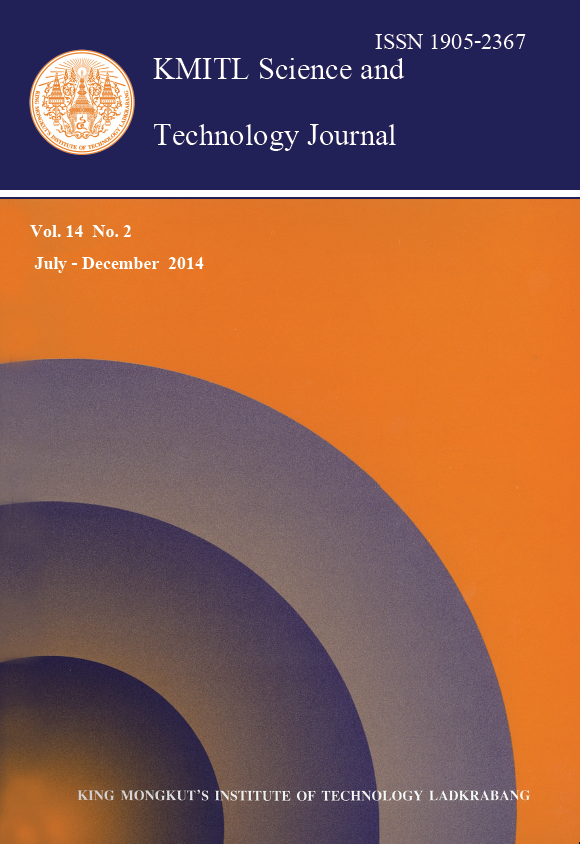Pretreatment and Enzymatic Hydrolysis from Water Hyacinth (Eichhornia crassipes)
Main Article Content
Abstract
Water hyacinth (Eichhornia crassipes) is a noxious aquatic weed which grows fast and is a lignocellulosic material containing cellulose, hemicellulose and lignin. It can be utilized to produce reducing sugar for bioethanol production. This research studied a production of reducing sugar from water hyacinth using physical combined with chemical method. The water hyacinth was milled and dried at 105 °C for 5-6 h, then pretreated with acid (sulfuric acid 2.0, 2.5 and 3.0 % v/v) and alkali (sodium hydroxide 2.0, 2.5 and 3.0 % w/v). After heating in an autoclave at 121°C for 15 min, it was found that using 2.0 % v/v sulfuric acid and 2.0 % w/v sodium hydroxide providing the highest reducing sugar of 15.63 and 2.35 g/L, respectively. Therefore, the sulfuric acid concentration of 2.0 % v/v was the most suitable concentration for pretreated water hyacinth. In addition, enzyme loading and time were studied for the optimization of reducing sugar production. The water hyacinth hydrolysate (sludge) was hydrolyzed with ACCELLERASE1500. The result showed that ACCELLERASE1500 loading at 0.30 ml/g water hyacinth and incubated at 50°C for 48 h produced reducing sugar of 11.95 g/L. This is a first report on enzymatic hydrolysis of water hyacinth by ACCELLERASE1500.
Keywords: water hyacinth, pretreatment, enzymatic hydrolysis
*Corresponding author: kodaungj@kmitl.ac.th, gwang_at@hotmail.com
Article Details
Copyright Transfer Statement
The copyright of this article is transferred to Current Applied Science and Technology journal with effect if and when the article is accepted for publication. The copyright transfer covers the exclusive right to reproduce and distribute the article, including reprints, translations, photographic reproductions, electronic form (offline, online) or any other reproductions of similar nature.
The author warrants that this contribution is original and that he/she has full power to make this grant. The author signs for and accepts responsibility for releasing this material on behalf of any and all co-authors.
Here is the link for download: Copyright transfer form.pdf
References
[2] Nlewem, K.C., Thrash Jr, M.E., 2010. Comparison of Different Pretreatment Methods Based On Residual Lignin Effect on The Enzymatic Hydrolysis of Switchgrass. Bioresource Technology, 101, 5426-5430.
[3] Ganguly, A., Chatterjee, P.K. and Dey, A., 2012. Studies on Ethanol Production from Water Hyacinth-A Review. Renewable and Sustainable Energy Reviews, 16, 966-972.
[4] Conde-Mejia, C., Jimenez-Gutierrez, A., El-Halwagi, M., 2012. A Comparison of Pretreatment Method for Bioethanol Production from Lignocellulosic Materials. Process Safety and Environmental Protection, 90, 189-202.
[5] Singh, A., Bishnoi, N.R., 2013. Comparative Study of Various Pretreatment Techniques for Ethanol Production from Water Hyacinth. Industrial Crops and Products, 44, 283-289.
[6] Goering, H.K., Van Soest P.J., 1970. Forage fiber analysis (apparatus, reagent, procedures, and some applications). Agricultural Handbook no. 379. Agriculture Research Service-United States Department of Agricultural, USDA, Washington DC.
[7] Miller, G.L., 1959. Use of Dinitrosalicylic Acid Reagent For The Determination of Reducing Sugars. Analytical Chemistry, 31, 426-428.
[8] Sheikh, M.I., Kim, C.H., Lee, J.Y., Kim, S.H., Kim, G.C., Shim, S.W., Kim, J.W., 2013. Production of Bioethanol from Waste Money Bills-A New Cellulosic Material for Biofuels. Food and Bioproducts Processing, 91, 60-65.
[9] Juan, R., Lizeth, T., Giselle, A., Hader, C., Angel, P., 2013. Acid Hydrolysis of Water Hyacinth to Obtain Fermentable Sugars. Latinoamerican journal of oil & gas and alternative energy, 5, 101-112.
[10] Almeida, J., Modig, T., Petersson, A., Hahn, H.B., Liden, G., Gorwa, G.M, 2007. Increased Tolerance and Conversion of Inhibitors in Lignocellulosic Hydrolysates by Saccharomyces cerevisiae. Journal of Chemical Technology and Biotechnology, 82(4), 340-349.
[11] Xing, R., Qi, W., Huber, G.W., 2011. Production of Furfural and Carboxylic Acids from Waste Aqueous Hemicelluloses Solutions from The Pulp and Paper and Cellulosic Ethanol Industries. Energy & Environmental Science, 4(6), 2193-2205.
[12] Modig, T., Liden, G., Taherzadeh, M.J., 2002. Inhibition Effects of Furfural on Alcohol Dehydrogenase, Aldehyde Dehydrogenase and Pyruvate Dehydrogenase. Biochemical Journal, 363(Pt.3), 769-776.
[13] Liu, Z.L., Slininger, P.J., Dien, B.S., Berhow, M.A., Kurtzman, C.P., Gorsich, S.W., 2004. Adaptive Response of Yeasts to Furfural and 5-Hydroxymethylfurfural and New Chemical Evidence for HMF Conversion to 2, 5-bis-hydroxymethylfuran. Journal of Industrial Microbiology and Biotechnology, 31(8), 345-352.
[14] Nigam, J.N., 2001. Ethanol Production from Wheat Straw Hemicelluloses Hydrolysate by Pichia stipitis. Journal of Biotechnology, 87, 17-27.
[15] Delgenes, J., Moletta, R., Navarro, J., 1996. Effect of Lignocellulose Degradation Products on Ethanol Fermentations of Glucose and Xylose by Saccharomyces cerevisiae, Zymomonas mobilis, Pichia stipitis and Canndida shehatae. Enzyme and Microbial Technology, 19(3), 220-225.
[16] Singh, A., Singh, N., Bishnoi, N.R., 2010. Enzymatic Hydrolysis of Chemical Pretreated Rice Straw by Aspergillus niger and Aspergillus heteromorphous. Journal of Scientific and Industrial Research, 69, 232-237.
[17] Biond, P., Kuttiraja, M., Archana, M., Janu, K.U., Sindhu, R., Sukumaran, R.K., Pandey, A., 2012. High Temperature Pretreatment and Hydrolysis of Cotton Stalk for Producing Sugars for Bioethanol Production. Fuel, 92, 340-345.
[18] Ma, F., Yang, N., Xu, C., Yu, H., Wu, J., Zhang, X., 2010. Combination of Biological Pretreatment with Mild Acid Pretreatment for Enzymatic Hydrolysis and Ethanol Production from Water Hyacinth. Bioresource Technology, 101, 9600-9604.
[19] Hendriks, A., Zeeman, G., 2009. Pretreatments to Enhance the Digestibility of Lignocellulosic Biomass. Bioresource Technology, 100, 8-10.
[20] Qi, B., Chen, X., Shen, F., Su, Y., Wan, Y., 2009. Optimization of Enzymatic Hydrolysis of Wheat Straw Pretreated by Alkaline Peroxide Using Response Surface Methodology. Industrial and Engineering Chemistry Research, 48(15), 7346-7353


